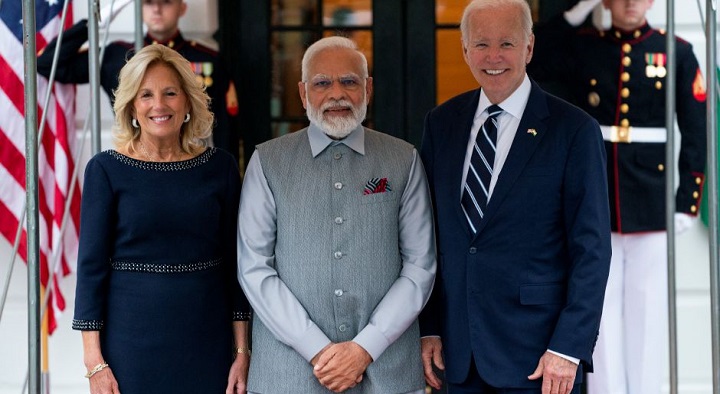
On June 21, the US enters summer 2023 with multiple foreign policy challenges impacting each other and yet to be handled on their own. They all spin around China.
The most important and tricky one is the visit to Washington of India’s Prime Minister Narendra Modi. For him, President Joseph Biden has rolled out the red carpet. Modi is expected to be to Biden almost what Mao in 1972 was to Nixon: a game-changer in a Cold War, then against Russia, now about China.
India has surpassed China in population size, and its people are almost ten years younger than the Chinese. India speaks English as an official language, its courts practice the Common Law, and it is a democracy, although wobbly sometimes. This last issue is the most controversial.
Some in the US accuse Modi of wanting to eviscerate India’s democracy and support human rights abuses against Muslims and minorities. These voices can’t be trifled with; they are certainly a stumbling block on the path to smooth bilateral ties in American rights-sensitive society. But the US lives and thrives between realistic and idealistic pulls.
When Nixon toured Beijing, roads were lined with organized crowds chanting, “Down with America.” As US experts in the mid-1970s were advising the People’s Liberation Army (PLA) on better tactics and weapons against the Soviets, the American press was blasting the Cultural Revolution in the Middle Kingdom. Incidentally and coincidentally, one of those US experts in China, Edward Luttwak, now openly advises India.
Now US and India have signed a several cooperation agreements covering defense procurement, joint weapons production and development of critical technologies.
Allied enough
Also, China never quite became a “US ally” during its political honeymoon with America in the 1970s and 1980s. Still, it played a crucial role against the Soviets.
Over-speculating that human rights concerns and India’s long-established “non-aligned” policy will derail bilateral ties could miss the point. The US needs India as an overall China’s counterweight; India needs the US to oppose multiple military and political challenges from China.
Moreover, the “de-risking” policy is a boon for India, as it stands to host foreign investments moving out of China. India is one of the biggest beneficiaries of the US policy toward China. If the US makes up with China, India then stands to lose on many fronts.
It is reinforced by the vanishing weight of Russia after the humiliating performance in Ukraine. Moscow was, for over 70 years, a star in Indian firmament. Without the US, India would miss a rare economic and political growth opportunity. Thus, India has a vested interest in pushing anti-China competition.
This blurs Indian concerns also about US policies on Iran, Pakistan, and Myanmar. Delhi and Washington do not see eye to eye on that.
Besides, India is not only looking at America. It has deep and deepening economic and military ties with Japan, Vietnam, and South Korea, all partners in America’s new band of companions against China.
The real problem with India is its capacity to deliver. Here China is so far unbeatable. In 20 short years, it built more railways, highways, ports, airports, and infrastructure than the rest of the world. India’s performance here is, at best, lackluster. India needs a boost in infrastructure similar to that of China at the same speed. It is not happening. If India doesn’t gain momentum in the next few years, many things could peter down.
In fact, China has been quite the busy bee moving around the world, stepping into all the weak spots of US diplomacy. It brokered a deal between Saudi Arabia and Iran, opening up a potential corridor from Afghanistan to Eritrea and Djibouti.
It cozied up to the Palestinians, thus signaling to all Arabs. It is expanding ties in Africa and Latin America. It was setting up surveillance structures in Cuba, and sent Prime Minister Li Qiang to Germany and France this week to remind Europeans that their economies are tied to China and they better “de-de-risk.” All these actions tell the world China is not in the American hands, it has a lot of room for maneuver.
All these Chinese actions are a problem for the US and its apparent strategy of tightening a grip around China—but even more so for India. Delhi may get just the leftovers if Beijing strikes back with effective global policies.
Three Chinese Strengths
China has three major strengths vis-à-vis efforts to corner it.
The US needs China’s exports; they are not simply part of its market but part of its production cycle. Chinese components are in many industrial products in America and the world, and they end up in the US one way or another. To root Chinese elements out of global imports to America is not easy.
The US needs China to buy Treasury bonds. Without Chinese purchases, the US market would shrink, and interest would shoot up.
The US needs China’s help with fentanyl, whose chemical components are exported from China. Fentanyl is one of the main drivers of the drug epidemic tearing apart every fiber of American society.
Of course, these are instruments that China can’t wield easily. It has every interest in continuing to export its goods to the US and the world. Chinese goods are essential to the US, but global money is at least as necessary to China.
It needs US T-bonds and dollars as currency to trade. It has no interest in being besmirched as a “drug dealer” regarding fentanyl.
However, China’s biggest problem is that it doesn’t really have a currency that can replace the dollar. If it promotes the use of the RMB abroad, its value will fluctuate compared to the domestic one, controlled by Beijing’s Central Bank, thus undermining Beijing’s treasured currency stability. If it doesn’t, it can’t escape the dollar’s “tyranny,” as money is the primary means of communication; it comes with rules and norms that China brands as “American centrism.”
As Premier Zhu Rongji saw in the late 1990s, China should devise plans to have a fully convertible RMB to escape this trap, which entails political changes. With a fully convertible RMB, money will come in or flow out. Thus, governments can fall because of a financial crisis. In a democracy, it is manageable; if a government goes down, another one will come in future elections. In an authoritarian system, things could be more complicated.
Moreover, China doesn’t have technological superiority. Its technology is catching up; its price-quality ratio is excellent. But it doesn’t possess a technology vital to the whole world. Replacing its technological products can be costly, but it is manageable. In less than a year, Europe weaned itself off all Russian gas imports, which made up a large chunk of EU needs (60% of gas in Germany and 40% in Italy), and gas is more vital than consumer goods.
Thanks to these three elements, China thinks it can bargain for some time, and many things could turn around with time. Perhaps it is true. But it also gives a time constraint to India. Delhi might want to hammer out its new role in the world before China comes around and might cut a new deal with America.
In this light, the actual game is between India and China, spooling around America and Japan. Then, in theory, a China-India agreement could spin all politics in a very different direction. Still India has tried to bet on China for over 20 years, and it failed miserably; possibly, it feels it wants to use the next 20 years to try something else. But for this, cozying up to America could be only a part of the play for both the US and India.





